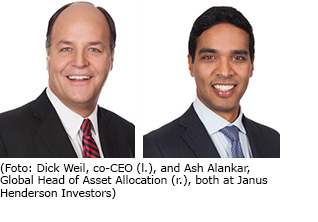
Janus Henderson: Active investment strategies gain momentum
The prevailing tide might be turning for passive investment vehicles, in favour of active strategies, so Dick Weil, co-CEO, and Ash Alankar, Global Head of Asset Allocation, both at Janus Henderson Investors.
12.02.2018 | 09:25 Uhr
 With returns on instruments such as certificates of deposit at US banks currently offering yields so far below inflation, savers are guaranteed to lose purchasing power by holding them.
With returns on instruments such as certificates of deposit at US banks currently offering yields so far below inflation, savers are guaranteed to lose purchasing power by holding them.
It is too expensive to sit on the sidelines and pause to assess what you want to do with your cash. Investors are forced into the game. Low interest rates stemming from ultra-accommodative monetary policies mean investors have to take on more risk because holding cash and equivalents is no longer an option.
Because the lack of return from holding cash is driving risk-taking, uncompetitive companies are getting unwarranted attention, with the result that good and bad companies start to look like one another on stock performance. When all companies start to look alike, the environment is extremely challenging for active management. The more dissimilar companies look, the more heterogeneity, the greater the opportunity set for active management.
Problems caused by homogeneity
By cutting rates to historical lows, the US Federal Reserve (Fed) and central banks around the world have brought homogeneity to the market and caused so many distortions and imbalances that it has been tougher for active management to add value. As a result, many active strategies have been challenged. This likely has helped boost the popularity of passive investment vehicles such as index-tracking mutual and exchange-traded funds over the past several years.
The ultra-low interest rate environment is somewhat akin to removing timeouts from basketball or rounds from boxing. If there were no timeouts, basketball coaches would lose the ability to take a pause to assess their options and strategies, while less skilled substitutes would get more court time as the star players tire. The effect would be the same as if there were no rounds in boxing — skill and strategy would be trumped by endurance.
But the tide should be turning.
The Fed has raised its target rate five times since December 2015, to 1.5%, followed by perhaps three more this year. That tightening is beginning to show through in short-term rates, with the yield on three-month Treasury bills climbing to 1.39% as of 4 January 2017, from 0.5% at the start of 2017, and one-year rates rising to 1.82% from 0.9% over the same time comparison. Both are now at their highest levels since 2008.
As these short-term yields edge closer to inflation, which sits at about the Fed's 2% target according to the consumer price inflation (CPI) measure, it is akin to bringing timeouts back into basketball or rounds back into boxing — investors will be able to take a break, gather their thoughts and examine potentially better ways to secure acceptable risk-adjusted returns. And in one fell swoop a major structural challenge that has limited the opportunity set and performance of active fund managers diminishes.
Interest rate normalisation to expose sinking companies
The normalisation of interest rates means there will no longer be a rising tide that floats all boats, irrespective of seaworthiness. Zombie companies that have been kept on life support by the availability of cheap money, and by investors who have been forced to allocate capital to them as they chase ever-dwindling returns, will be found out for what they truly are.
With interest rates normalising, investors can turn to their best picks and take time outs when they need to reassess their positions. Higher-quality companies will differentiate themselves as investing becomes less reliant on predicting single factor ‘risk on’ moments arising from central bank policy. Fundamental differences between companies will drive very different stock prices and investment results, giving high-quality active asset managers an opportunity to deliver substantially better risk-adjusted returns than passive benchmarks.
So while active managers have operated in a challenging environment for several years, it is a circumstance that should change when interest rates normalise, putting them in position to add more value.
This article was first published in Pensions & Investments Magazine on 16 January 2017: http://www.pionline.com/article/20180116/ONLINE/180119924/commentary-passive-has-been-on-a-tear-for-a-reason-8211-and-it-isnt-fees (pay-walled link). Republished here with their permission.



Diesen Beitrag teilen: